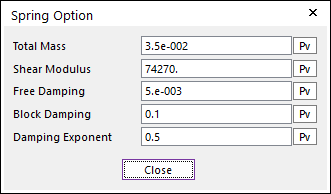

Figure 1 Spring Option dialog box
•Total mass: The mass of the spring. For a detailed description of the axial mass distribution of the single segment bodies, please refer to Note 2 of this section.
•Shear Modulus: Shear Modulus is used in the calculation of the axial stiffness force splines during the static compression pre-calculation, thus directly influences the spring stiffness characteristics with a linear dependency to that value. The Shear Modulus is typically used to adjust the calculated spring stiffness to measured spring data. The calculated values for the stiffness of a free segment (no contact to other segments) "c_0" and for a full-contact segment (segment is completely "on block" with another segment) "c_k" are display in the spring generation log file under the "Interpolation of force, stiffen, calculation of damp." information block.
•Free Damping, Block Damping and Damping Exponent: MMS Type B contains a displacement dependent damping behavior. The values for Free Damping, Block Damping and the Damping Exponent directly influence the damping force splines calculation during the static compression pre-calculation. The damping splines contain a damping coefficient vs. relative segment displacement relationship. This takes into account that the damping characteristic of a spring changes due to additional energy dissipation based on the friction from the relative movement of two coils during a coil contact situation. The values for Free Damping and Block Damping are dimensional - less damping values (based on Lehr's theory) and NOT velocity depended damping values typically used in MBD program, meaning that such a damping value which equals 1 would be equivalent to a critical damping between two segments. The velocity dependent damping coefficients for a free segment "d_0" are calculated from the following formula:

•The velocity dependent damping coefficients for a full block segment "d_k": The velocity dependent damping coefficients for a full block segment "d_k" is calculated with the same formula using c_k and Block Damping respectively. The Damping Exponent is used to characterize a smooth transition between free segment damping d_0 and block damping d_k i.e. is used to calculate the damping value if only a portion of a segment is in contact with the neighbor segment. From experiments a value of 0.5 for the Damping Exponent has shown to be an adequate value. The calculated values for the damping of a free segment (no contact to other segments) "d_0" and for a full-contact segment (segment is "on block" with another segment) "d_k" are display in the spring generation log file under the "Interpolation of force, stiffness, calculation of damp." information block.